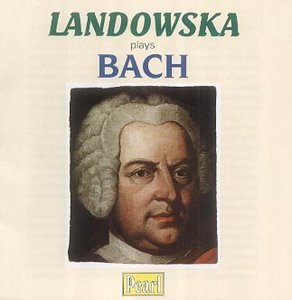Pearl has now built up a formidable corpus of reissues
devoted to the art of the remarkable Wanda Landowska and her outsize
Pleyel. Each disc bears the weight of her idiosyncratic but unignorably
illuminating musicality and this latest issue is especially valuable
for presenting, in such good sound, a March 1947 performance of the
English Suite No 2 in recital at the Frick Museum, New York. It is intelligently
complemented by the Sixth French Suite, the Toccata in D Major and a
Concerto, the D Minor, all commercial recordings from 1936-38. The last
is further illuminated by the detailed recording details provided by
Landowska protégé Denise Restout who, it now emerges for
probably the first time, played Harpsichord basso continuo at the recording
sessions.
The Toccata emerges in splendid relief, with a dramatic
opening movement and an Allegro replete with almost saturnine trills
but reaches a peak of eloquence in the long fourth movement where her
control is superb. And in the final Fuga how humorously she brings out
the emergent voicings. The English Suite, as I say, is in excellent
sound. She’d already recorded it, in Paris in 1936 but this live Frick
performance has, as that earlier commercial recording had not, all the
repeats. Some coughs and a few minor scuffs at the beginning of the
Bourrée I are all that will intrude, Pearl having done a clearly
excellent job with some pitching and static problems elsewhere through
judicious use of equalization. Landowska is rhythmically emphatic in
the Prelude, serves up some extreme filigree treble in the Courante
and some freely moving dramatic bass sonority in the Sarabande. She
is implacably vivacious in the Bourrée II and performs with imaginative
and intellectually satisfying commitment. The French Suite shows similar
virtues from the previous decade; the oppositional material of the Sarabande
is swept up by her into a mini-tableaux of real theatricality whilst
the concluding Gigue is animated, technically adroit and played with
fiery zest.
The Concerto was recorded over several days in December
1938. Bigot was something of a discographic monopolist of this work,
inasmuch as he recorded it three times. Restout tactfully omits to mention
the name of the pianist with whom Bigot had previously recorded the
work "without any special knowledge of Bach’s style…in a straight-forward
manner" (it was actually that fine musician Marguerite Roesgen-Champion
accompanied by the Lamoureux). Bigot himself went on to record it again
with Alexander Borovsky in the Busoni arrangement. A photograph from
the recording sessions with Landowska is reproduced – as is Restout’s
recollection of the composition of the orchestra, a very small, authentically
sized 8 strings - 2,2,2,1,1. A quick head count of the visible players
seems to show a slight discrepancy but she was there and it doesn’t
much matter – the band is the antithesis of the Stokowski-Wood-Koussevitsky
School of 1930s Bach playing. There is tremendous vigour and drive in
the opening movement with the orchestra responsive to the obviously
unaccustomed dynamics of the harpsichord-strings relationship. She emphasizes
the finality of the movement with a lengthy final dying note, sustained
for a daring time. What elevates the slow movement is the almost improvisatory
element of her playing, one that, despite the anachronistic size of
her chosen instrument, never renders her playing either mechanical or
predictable. Even if one tends to side more with a pianist contemporary,
say Harold Samuel, with Landowska one always consumed by the invincible
life of her playing, its glinting and darkening truth and its power
still to affirm and move.
Jonathan Woolf


